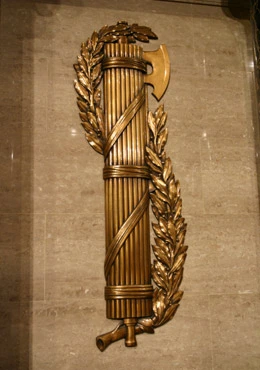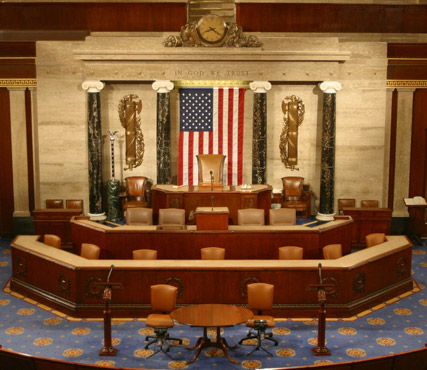
–by Maggie Esteves
I remember my first tour of the Capitol: I felt overwhelmed at the hugeness of the building, the depth of the history, and the beauty of the Rotunda and other rooms. It wasn’t until months into this job that others—with keener eyes than mine—began pointing out to me the deliberateness of the details in the Capitol and the ways they enhance the very meaning of the building.
Symbolism is everywhere in Washington, especially in the Capitol. Architects over the decades heard the opinions of hundreds of Congressmen and Senators while they were building, so few things were created without a distinct purpose. So when I was asked if the symbol of an axe and reeds next to the Speaker’s rostrum in the House of Representatives had meaning, I knew the answer was “yes” and did some digging to find out why.

This ancient emblem called a fasces served as the symbol of civil authority in the Roman Republic. Originally it was an axe bound among a collection of rods held together with a red strap. The fasces could be presented to restore order or to carry out punishment. Our founding fathers found deep inspiration for our own democratic experiment from the Romans and adopted the symbol to represent Congress. Just as the thin rods of the fasces become stronger when bound together, so the states find stability and strength while working collectively in the House and Senate in the Capitol building.
As I began sharing the history of this ancient symbol I also started noticing the motif of bound rods popping up again and again in the design and art of the building:



This ancient symbol takes us from the Roman Republic and the ideas that formed the foundation of our American governmental system to the daily struggle for compromise and unity that is played out inside the U.S. Capitol building. It’s a small detail with big meaning.
Where else might you have seen this symbol from antiquity? Have you ever passed by the same building or scene so many times and failed to see details lost in plain sight? Stop and have a deeper look today! You never know what you might discover.


Wow that symbol is everywhere! It makes the history so much richer when you know the meaning behind it!
In fact no matter if someone doesn’t know afterward its up to other
viewers that they will help, so here it occurs.
That is also the symbol of fascism. It is in fact the root word of FASCism as defined by the Italians.
Yeah this is a fascist symbol, I think its time to get it removed
You need to grow up and study about it more.
it was co-opted by bad people, it doesn’t make the symbol itself bad
That’s not the only root meaning of the word. In medicine, anatomy and physiology, the correlated word is fascia. It’s a type of tissue, a layer, that holds other tissue and organs together in place. Makes the body stronger and more resilient. Must you go directly to a concept some would view negatively? Some might say fascism is good, from a certain point of view!!!
This symbol was used for a while for the Civics merit badge in the BSA as well
Hi, I do think this is an excellent blog. I stumbledupon it
😉 I am going to come back yet again since i have book marked it.
Money and freedom is the best way to change, may youu be rich and continue
to guide other people.
I’m afraid your history of the fasces is incomplete and circumspect. The fasces was specifically the symbol of the Roman dictator, who in times of crisis was given absolute power until the crisis passed. It didn’t symbolize compromise, but the unquestioning support by the public (the rods) of the dictator (the axe). When Rome passed into the imperial era, the emperor was officially “dictator for life”. The word “fasces” is also the root for the word “fascism,” and is the symbol of modern fascist movements, starting with Italian fascism under Mussolini, then spreading to Spain, and finally Germany, where the fasces is prominently used in Nazi icongraphy and art. It is true that the USA has used it much longer than modern fascists, but its Roman origin and legacy is not one freedom or democracy, but of fearful repression and dictatorship.
The fasces only became a symbol of fascism and absolute control over government and civil life later in history and after some retrospection leading to its adoption by the Italian fascist movement. Originally the fasces was carried by lictors and was used to show their commanding officer’s rank his and power over life and death while on military campaign. The reason the distinction between being on campaign and not is important is because military commanders were not allowed to enter the sacred boundary of the city of Rome (where civil power over the nation was vested) as anything other than private citizens. To do so would be a major religious and cultural faux pas (because of the connection between that action and the legendary contest between Romulus and his brother). When they entered the city the ax blades were removed from the fasces because having come back from campaign, power over life and death (symbolized by the ax) was left to the rule of law by assembly.
The reason it’s a fascist symbol is because of Julius Ceasar’s decision to march on Rome and cross the pomerium (the sacred border) at the Rubicon with his military command and the ax on his lictors’ fasces intact, seizing power over the government. It would later become a symbol of Ceasar’s rise to Dictator.
In a Late Modern Period sense, the use of the symbol of a fasces with an ax in places of assembly was to show the power of that body and rule of its laws. In a republic like America, it was to be a symbol that was empowering to the people whose elected officials comprised that body.
excellent Post…. and right on the money… thanks
The fasces is a cavity magnetron like the 1 inch one in your microwave, but somewhat longer.
A weapon of a ‘fascist’ nature, dominating all in its path.
it reminds me of the $ symbol.
The fasces is a bundle of sticks